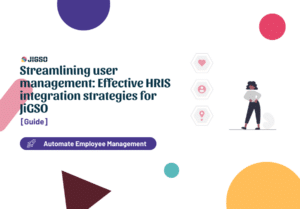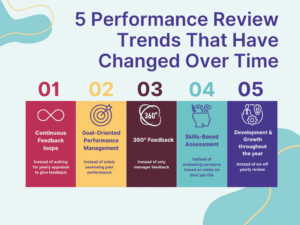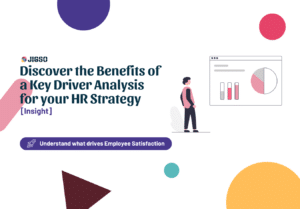In today’s competitive business landscape, employee engagement is no longer a “nice to have” – it’s a critical factor for success. Engaged employees are more productive, satisfied, and invested in the company’s mission. They’re less likely to leave and more likely to go the extra mile, leading to a ripple effect of positive outcomes for the organization.
Here’s a glimpse of the power of employee engagement:
- Gallup research shows companies with higher engagement experience 81% fewer absences, 23% higher profitability, 18% higher productivity, and 10% higher customer engagement.
- A study by The Engagement Institute estimates that disengaged employees can cost companies a staggering $550 billion annually.
The bottom line? Tracking employee engagement is essential for measuring your organization’s health and identifying areas for improvement. But with a plethora of metrics available, which ones should you focus on?
This blog post dives into 8 key employee engagement metrics and KPIs (Key Performance Indicators) you can track to gain valuable insights into your workforce and optimize your employee experience strategy.
Employee Engagement metrics and KPIs to track
To gain deeper insights into employee satisfaction and drive positive changes, we recommend tracking the following engagement metrics.
1. Employee Net Promoter Score (eNPS)
The Employee Net Promoter Score (eNPS) is a measurement that assesses employee loyalty and engagement by asking a single question: “On a scale of 0-10, how likely are you to recommend our organization as a great place to work?” Based on their responses, employees are segmented into three categories:
How to measure eNPS
Promoters (score 9-10): Highly satisfied employees who actively promote the organization.
Passives (score 7-8): Moderately satisfied employees who may be prone to attrition.
Detractors (score 0-6): Disengaged employees who wouldn’t recommend the company and may have a negative impact on the organization.
To calculate the eNPS, subtract the percentage of Detractors from the percentage of Promoters. Note that the Passives are excluded from the calculation. The resulting score can range from -100 to +100.
eNPS = % Promoters – % Detractors
Thus, suppose a company has 100 employees. Out of these, 60 employees are Promoters, 25 employees are Passives, and 15 employees are Detractors. The eNPS would be calculated as follows:
eNPS = (Promoters – Detractors) / Total Respondents * 100
= (60 – 15) / 100 * 100
= 45%

Conduct regular eNPS surveys using online tools or through your employee experience platform (like ours!).
2. Voluntary employee turnover rate
Voluntary employee turnover rate measures the percentage of employees who choose to leave the organization over a given period. This metric specifically captures resignations that are initiated by the employee rather than by the employer.
While every company experiences some level of turnover due to natural career progression or personal reasons, a consistently high turnover rate can signal deeper issues within the organization. These could include limited professional development opportunities, insufficient Diversity, Equity & Inclusion (DEI) initiatives, a non-inclusive team culture, or poor work-life balance. Understanding these factors can help companies address the root causes of turnover. Refer to our blog post on key driver analysis to identify the specific drivers that have the most significant impact on your organization.
How to measure voluntary turnover rate
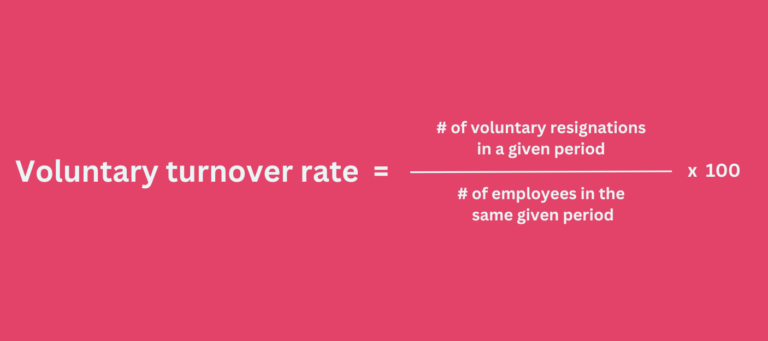
3. Employee retention rate
Employee retention rate is a metric that reflects the percentage of employees who remain with an organization over a set period. It serves as an indicator of how well a company retains its talent and whether employees feel engaged, valued, and committed to the organization. High retention rates typically signal that employees are satisfied with their roles and see a long-term future with the company.
A high retention rate helps minimize the significant costs associated with turnover, such as recruiting, onboarding, and training new employees. It also reduces the disruptions caused by frequent staff changes, leading to a more stable and productive workforce. Building a supportive environment where employees feel their contributions are valued not only enhances retention but also fosters a stronger, more cohesive team. When employees are satisfied and engaged, they are less likely to seek opportunities elsewhere, leading to sustained organizational success.
How to measure retention rate
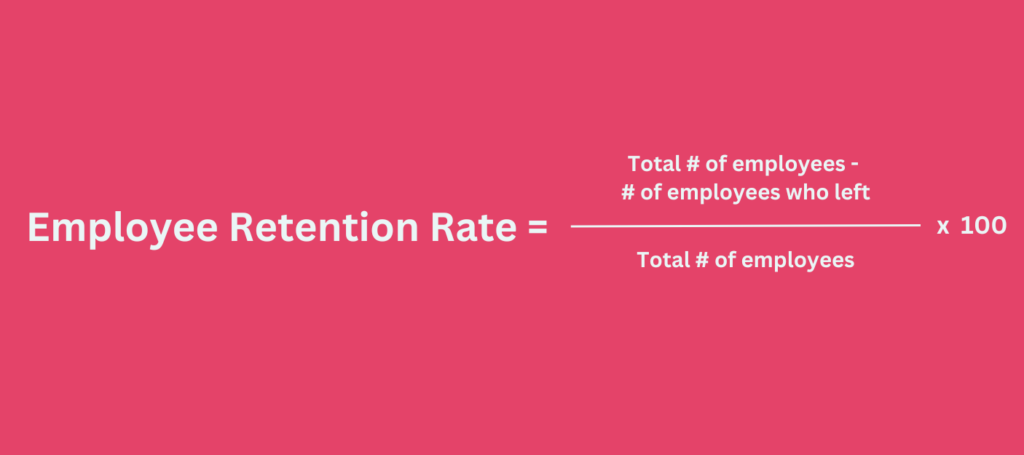
4. Professional Development
Thriving workplaces prioritize professional growth, recognizing that when employees are given opportunities to advance and enhance their skills, they not only become more engaged but also contribute more effectively to the organization’s success. Top talent, in particular, seeks roles that offer clear pathways for advancement and skill development. Personal growth often leads to improved performance and increased productivity, both of which are key engagement metrics. By encouraging employees to invest in their own development, companies can foster a culture of continuous learning and improvement.
How to measure professional development
To measure professional development effectively, it’s important to establish clear, objective goals for each employee. These goals should be tailored to individual roles and departments, as the competencies required for advancement can vary widely. Using the SMART (Specific, Measurable, Achievable, Relevant, Time-bound) framework within our JiGSO Goals module, employees can set effective and meaningful goals.
Our JiGSO Performance module offers flexible templates and automated tracking to create and monitor customized development plans. By assessing completion rates, utilization, and the impact of development initiatives on individual and organizational goals, you can gain valuable insights into your professional development programs. Additionally, utilizing the 9-grid talent box can help identify potential stars within your organization, allowing you to incentivize these high-potential employees to grow and excel in their roles.
Other interesting reading

Setting Effective Goals using the SMART Framework
Learn how to set and achieve goals effectively using the SMART framework. This blog explores each element of SMART—Specific, Measurable, Achievable, Relevant, and Time-bound—offering practical
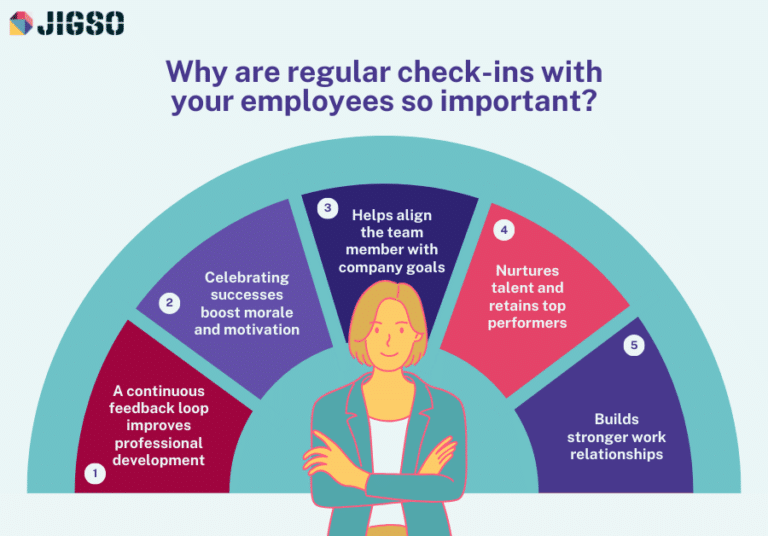
Why is continuous performance management so important and how to do it.
This blog will explore the role of continuous performance management in modern workplaces. It will emphasize the importance of regular performance assessments in fostering employee
5. Absenteeism
Absenteeism measures the number of days employees are absent from work, excluding approved leaves. High absenteeism can signal employee engagement issues and create additional workload for others, leading to increased stress and decreased job satisfaction.
Absenteeism is more than just an individual issue; it can have a ripple effect throughout an organization. When absenteeism rates are high, the added burden on other employees can lead to a cycle of increased stress and burnout, which can further exacerbate disengagement and even prompt additional absenteeism.
This behavior can create a negative atmosphere, reducing morale and overall team cohesion. Moreover, absenteeism is often symptomatic of deeper organizational problems such as poor working conditions, ineffective management, lack of leadership, or an imbalance between work and personal life.
How to measure absenteeism

6. Recognition
Creating a culture where great work is regularly acknowledged is crucial for fostering a positive workplace environment. Publicly recognizing achievements not only boosts motivation and engagement but also reinforces your company’s core values and desired skill sets.
When recognition becomes a habit, it encourages others to express appreciation, contributing to a more supportive and engaged team.
How to measure recognition
To effectively measure and enhance recognition, strategic and creative approaches are necessary. Our platform, for example, offers features like an Instant Feedback Wall, where employees can publicly acknowledge their colleagues for “You always raise the bar” or “You bring good vibes.” You can gauge the impact of recognition by tracking how many employees use these tools and by gathering feedback through surveys to see if these initiatives are positively influencing their work experience.
7. Work-life balance
“Work-life balance” has become increasingly important in recent years, especially since the World Health Organization (WHO) classified burnout as an “occupational phenomenon” in 2019. A 2021 study by the WHO and the International Labor Organization highlighted the dangers of overwork, revealing that working more than 55 hours per week significantly increases the risk of heart disease and stroke.
Feeling overloaded is one of the biggest threats to employee satisfaction and engagement, often leading to burnout. By tracking workloads across your team, you can identify who might be at risk of overwork and ensure that tasks are distributed more evenly, preventing engagement from dropping due to excessive stress.
How to measure work-life balance
The simplest way to gauge work-life balance is through employee surveys. Ask questions like, “How satisfied are you with your work-life balance on a scale of zero to ten?” Other effective questions include asking about satisfaction with the time available for hobbies, family, and rest.
8. Employee engagement survey participation rate
This metric tracks the percentage of employees who participate in engagement surveys. A high participation rate indicates that employees feel their opinions are valued and are willing to provide feedback.
How to measure participation rate
Our Employee Listening module makes it easy to deploy engagement surveys and track participation rates. By regularly reviewing these rates, companies can gauge employee willingness to engage and provide feedback on workplace issues.
How to choose the right employee survey tool
Conclusion
Employee engagement metrics and KPIs are vital for understanding and improving how employees feel about their work and their company. By systematically tracking these metrics, organizations can create a more engaged, productive, and satisfied workforce. Utilizing our employee experience platform, with its comprehensive tools for feedback, recognition, and performance management, can significantly enhance your ability to monitor and boost engagement across the board.
Incorporating these metrics into your regular HR processes will not only help in retaining top talent but will also drive the overall success of your organization. Start tracking these metrics today to unlock the full potential of your workforce.

